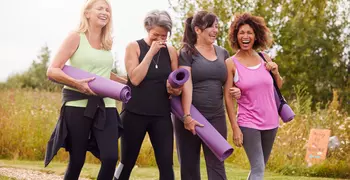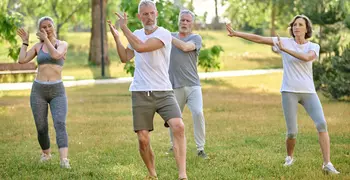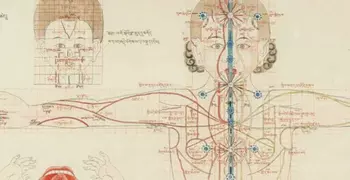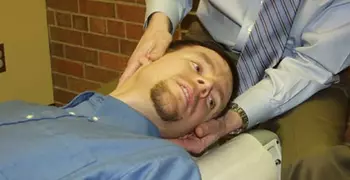
What is yoga?
 Yoga is a spiritual tradition that began in India about 5,000 years ago. Historically its practices have been adopted by such religions as Hinduism, Jainism, and Buddhism. However, the practice of yoga is compatible with any religion, as well as atheism.
Yoga is a spiritual tradition that began in India about 5,000 years ago. Historically its practices have been adopted by such religions as Hinduism, Jainism, and Buddhism. However, the practice of yoga is compatible with any religion, as well as atheism.
The word yoga means union in Sanskrit. Many of the yoga traditions believe that the practices of yoga lead to union of a person with his or her true nature, or with God or the universe (however one wishes to conceptualize it). How this is interpreted and the means employed to get there differ in the various yoga traditions.
Patanjali, author of the classic yoga text, the Yoga Sutra, defined yoga as the quieting of the fluctuations of the mind. From a yogic perspective, the mind, and its ceaseless internal monologue, is the source of suffering. The various yoga practices serve to calm the mind. From a wellspring of relaxed concentration-the hallmark of yoga-comes inner peace, heightened creativity, and awareness of our essential nature.
Yoga is more than poses
When people in the West hear the word yoga, they usually think of the stretching and strengthening poses known as asana [AHS ah nah], which are the primary focus of most yoga classes. But asana is only one aspect of a multidimensional system that includes:
- Breathing practices, known as pranayama
- Meditation techniques
- Moral precepts against stealing, lying, doing harm to yourself and others, etc.
- Chanting
- Selfless service such as volunteer work, known as karma yoga
- Visualization exercises
- Study of yoga philosophy
Benefits from the practice of yoga
Stress reduction
Arguably the most comprehensive method of stress-reduction ever developed, yoga offers numerous tools to shift the balance of the autonomic nervous system to the parasympathetic side, calm the mind, and lower the levels of stress hormones such as cortisol.
Due to its ability to reduce stress, yoga is likely to be of benefit not just for those suffering from burnout and such stress-related conditions as insomnia and irritable bowel syndrome, but also in the treatment and prevention of leading causes of death, including heart disease, hypertension, and diabetes, all of which may be adversely affected by high levels of stress.
Other psychological benefits
Psychological benefits of yoga include relaxation, greater equanimity, better concentration, and improved mood.
There is substantial overlap between yoga practices and other mind-body therapies. Biofeedback techniques, in which patients are taught to tune into sensations in their body and regulate their breathing in order to facilitate relaxation of muscles, relieve stress or warm their hands and feet, are based on yogic principles.
Physical benefits
Yoga offers many physical benefits, including increased strength and flexibility, better balance and coordination, improved reaction times, better lung function, heightened cardiovascular conditioning, and weight loss.
Yoga practices have also been adapted in manual therapies. A number of physical exercises used in rehabilitation from injuries are based on yoga asana (postures). One example is the gentle backbends often used after back injuries.
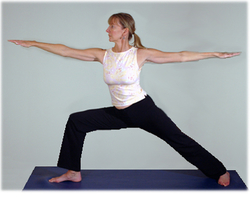 What does the research show?
What does the research show?
There has been an increased amount of research (particularly randomized controlled trials) on yoga's effects throughout the past few decades. Most of this research comes from India, although there are an increasing number of studies from researchers in the U.S. and England. Not all of this research is of high quality methodologically, but in recent years the quality has generally improved.
Types of medical conditions studied have included psychopathological (e.g. depression and anxiety), cardiovascular (e.g. hypertension, heart disease), respiratory (e.g. asthma), diabetes, and others.
Scientific studies have found yoga as a useful adjunct to the care of such conditions as asthma, arthritis, carpal tunnel syndrome, multiple sclerosis, and heart disease. In addition, in both India and the West, yoga is used therapeutically for many conditions based largely on experiential evidence. In North America, workshops are offered on hatha yoga for people with such conditions as HIV/AIDS, scoliosis, back pain, depression, pregnancy, and cancer
Some issues with the research
Although standardized protocols have been developed to meet the needs of scientific study, most yoga, and particularly yoga therapy, is personalized to the individual and is not strictly based on the Western medical diagnosis.
In addition, different techniques have different effects on each individual and even on one individual at different times or stages in his or her practice. Thus, what is typically measured in scientific studies of yoga doesn't reflect what usually happens in the real world. Yogis would also argue that the one-size-fits-all approaches used in clinical studies are likely to be much less effective than a personal yoga practice..
Where can I find a practitioner?
There are no universal standards or accreditation for either yoga teachers or yoga therapists. However, the Yoga Alliance is a national non-profit organization that certifies teachers from different traditions at either the 200- or 500-hour level of training.
Currently no states require licensure or certification for yoga teachers or therapists, although that may change in coming years.
The training and certification of yoga teachers will vary greatly. It is helpful to ask prospective teachers to describe the following:
- What style of yoga do they practice? (Iyengar, Ashtanga, Bikram, Anusara, Kripaulu, etc)
- How long have they been practicing yoga?
- What teacher training have they received?
- Do they have any other related physical training or education, such as anatomy and physiology?
- How do they modify the poses for those with physical or other limitations?
- What general safety guidelines do they suggest for the practice of yoga?
- What do they charge for the classes and are there any other fees?
Where can I get more information?
The Center for Spirituality and Healing at the University of Minnesota offers a fully online course, Yoga: Ethics, Spirituality and Healing. Courses are open to current students at the University of Minnesota, students at other academic institutions, and lifelong learners in the community. For assistance with registrations, or for more information, please contact Erin Fider.
You might also be interested in these resources:
Bikram's Yoga College of India
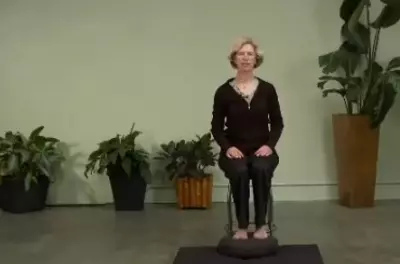
Learn chair yoga
Do yoga in your chair at work or wherever. Practice with this 15 min video.

Yoga for all ages
Do you envision a day where we will teach kids how to reduce stress just as we teach math and language skills?
It used to be that yoga, as well as other mind-body practices, were believed to be esoteric "flower power" exercises practiced in relative obscurity by people on the fringe of society and American culture. Cut to the 21st century where hospitals, community centers and wellness facilities around the country are teaching both yoga and meditation. In fact, yoga studios and centers like ours now dot the landscape of most cities.
The evidence base for the ancient practice of yoga is growing, and recent studies have reported it to reduce stress, improve sleep and lower blood pressure. Additionally, yoga is known to improve physical health by increasing strength and flexibility and to increase balance and coordination, as well as cardiovascular functioning.
Not surprisingly, yoga is now being used with children of all ages to some startling positive effects. A CNN article reported that teachers and parents are finding that yoga can help kids relax, become less agitated, and more focused. While there is firm documentation regarding the numbers of schools where yoga is being taught, there are a growing number of school districts across the U.S. that are even integrating yoga into the classroom. Check out this video describing the impact of yoga in the Minneapolis school district where 400 educators are using a program called Yoga Calm.
At the Center for Spirituality & Healing (CSH) at the University of Minnesota, we are getting more and more requests to offer mind-body skill training for children and adolescents and are considering adapting our successful Mindfulness Based Stress Reduction program for this purpose. We've met with representatives from the Goldie Hawn Foundation, who have been doing inspiring work with their MindUPTM program, a comprehensive mindfulness curriculum for children in grades K-7.
